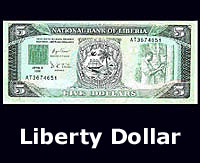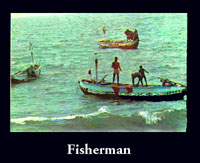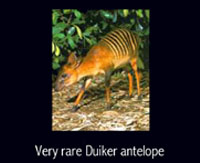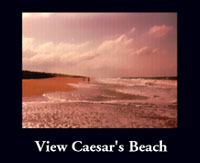Currency:
Till 1999 two kind of Liberian dollars were in existence - the JJ Roberts and Liberty, officially at par with the US dollar which is also legal tender in the country.
The new L-Dollar bills are published at page-77. On the parallel market in Monrovia, US$1 = L$40.

Radio Broadcast:
Stations AM: 3
Stations FM: 10
Shortwave: 0
Radios (1995): 675.000
TV Stations: 1
Televisions (1995): 56.000
Languages:
The official language is English; also several native languages are spoken.
Religion:
Liberia is officially a Christian state, but Islam (especially in the north) and traditional African beliefs
are also practiced.
Climate:
Tropical hot & humid with two main seasons, the rainy and the dry seasons. Wet cloudy summers with
frequent heavy showers from May to October, dry winter season from November to April.
|
|
ECONOMY
Liberia's free-enterprise system and open-door policy encourage trade and investment opportunities. Existing
industries and/or sources of economic activity that generate significant earnings in the labor and export
sectors of the economy include iron ore, diamonds, gold, rubber and forestry products, coffee, cacao and
palm/bamboo products. To expand industrial growth, the government is encouraging the establishment of
domestic industries that will be fed with local raw materials and products. Agricultural development is
increasing which activities include animal husbandry, fish farming, extensive lowland rice cultivation,
and diversification of staple and cash crops.
Geological explorations have revealed untapped reserves of Oil, Gas, Hydrocarbon and Uranium deposits, but
also economic base-potential commerical mining-quantities: Barite, Phosphate, Garnet, Corundum, Copper,
Lead, Zinc, Kyanite, Toumaline, Beryl, Topaz, Chronite; and such heavy minerals as Ilmenite, Rutile,
Picroilmenite, Monazite and Zircon.
Climate
Tropical hot & humid with two main seasons, the rainy and the dry seasons. Wet cloudy summers with
frequent heavy showers from May to October, dry winter season from November to April. Variations in
average temperature and relative humidity from one season to the other are not significant, although
a significant change occurs in relative humidity (from 78 down to 30 percent) during the months of
December to March when a dry natural hazzard Harmattan wind blows from the Sahara, resulting in hot
days and cold nights in January. Temperature between 15°C (65°F) and 35°C (95°F) in Monrovia typify
the extremes of coastal temperatures. Annual rainfall averages 200 inches (508 cm) along the coast,
and diminishes to about 70 inches (178 cm) farther inland, ideal for crops such as rubber, cacao,
coffee, okra, cassava (capioka), mango, papaya (pawpaw), palm oil, bananas and kola.
|
|
-
free enterprise system, zero tax jurisdiction
-
260 species of trees, amongst other: Mahogany, African Walnut, Mahere, Teak, Ebony, Ironwood, Makore, Sikon and Camwood.
-
200 different birds
Liberian Specialties
Angling:
St. Paul & Mesurado River, in Lake Piso and in the Atlantic Ocean

National Anhem:
All hail, Liberia, hail ...
Rare Animals

Pygmy Hippo or Hippopotatis Choeropsis Liberiensis (found in the lowland forest & swamps)Jenkin's Duiker
& Manatee. But also Crocodiles, Baboons, Boa constrictors, Flamingos, Parrots and of course the famous
Bulbul have their home in Liberia.
Beautiful Beaches
Bernhard's, Elwa, Kenema, Kendaje, Sugar, Cooper & Caesar's

|